At the 2021 Shanghai Auto Show, Huawei shocked all automakers and suppliers. Huawei has directly and indirectly supported more than 10,000 engineers in the R&D of intelligent automobiles. Except production, Huawei covers almost all of aspects required for digital transformation of automobiles: automotive perception and decision-making, network communications, electric drive, batteries, electric control, cloud-road networks outside vehicles, R&D and marketing.
Compared with the previous R&D investment involved with 1,000 persons (such as Baidu), Huawei's R&D team consisting of 10,000 persons has greatly accelerated the upgrade pace of intelligent networking of China's auto industry. When other countries around the world are still worrying about the pandemic, China will enter the era of leading the development of global automotive intelligent networking from 2021.
Take LiDAR installation as an example, the new models with LiDAR mainly come from domestic automakers.
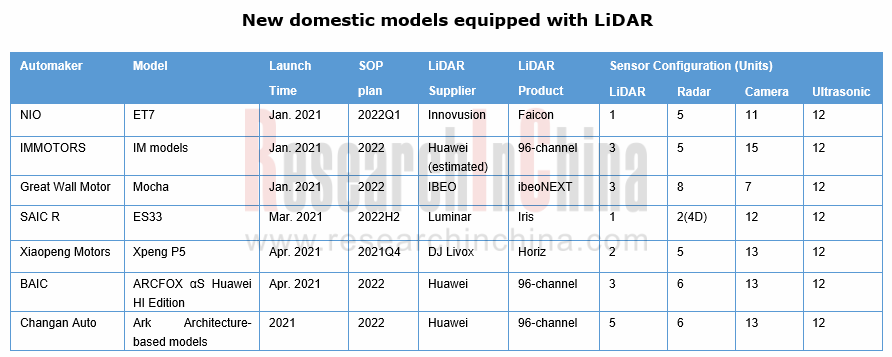
On April 14, Xpeng's third mass production car, the P5, was launched. The biggest highlight is that it is equipped with two DJI Livox LiDARs, which can realize the NGP function on urban roads. Following NIO ET7, Great Wall Mocha, IM and SAIC ES33, P5 is another new model equipped with LiDAR.
On April 17, the ARCFOX Alpha S Huawei HI equipped with three Huawei’s 96-channel LiDARs (installed on the center and both sides of the front) was officially unveiled; later, Changan’s model based on the Ark architecture will also be equipped with Huawei’s LiDAR.
The second model of Lixiang will also be equipped with LiDAR.
After years of development, automotive LiDAR technology roadmaps and products have been quite diversified. ResearchInChina has sorted out classification and composition of LiDAR, as shown in the figure below.
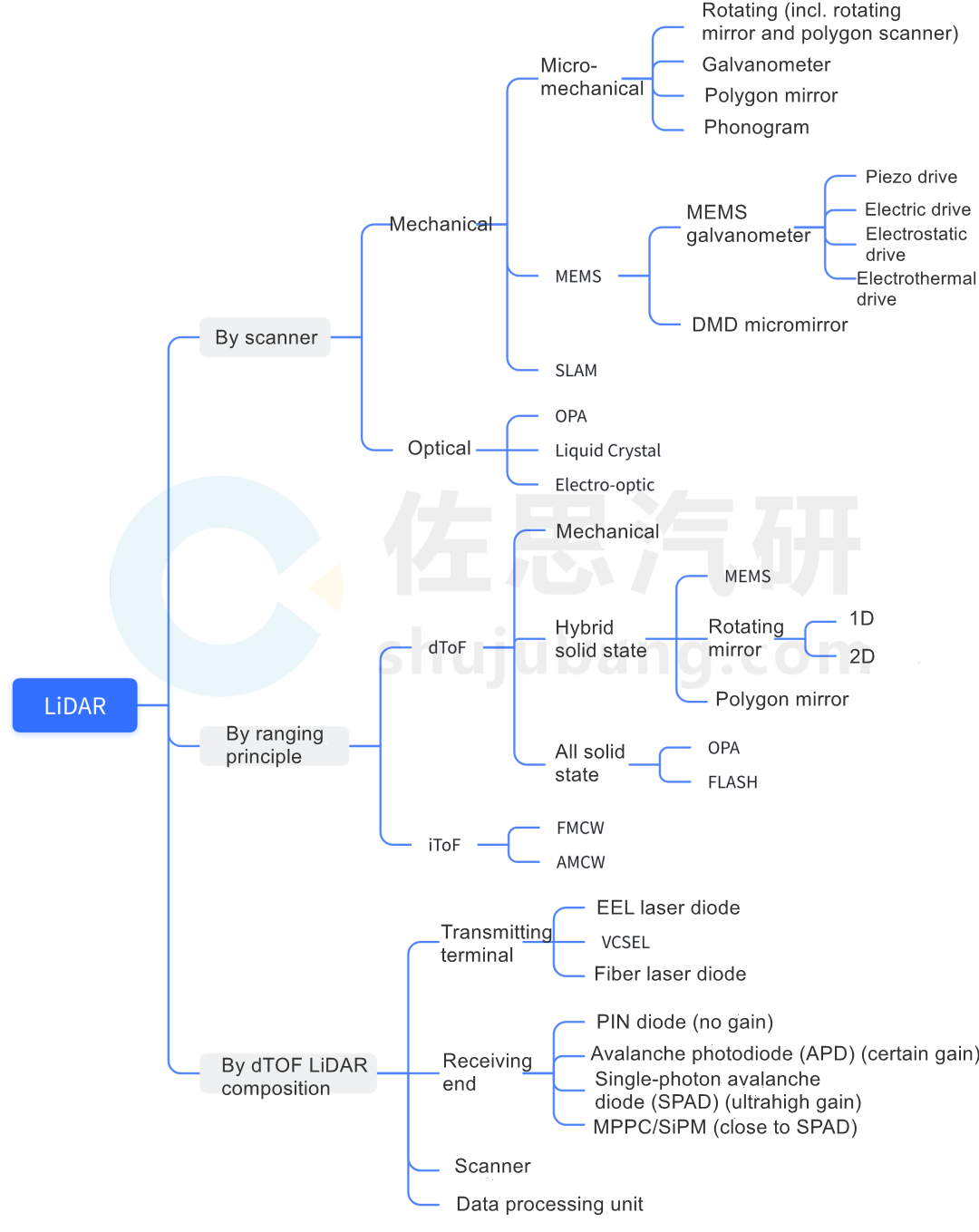
Early, LiDAR was mainly used in Robotaxi, Robotruck, Robobus, low-speed autonomous driving and roadside perception, etc. in small scale. The extensive application of LiDAR depends on the passenger car market.
As L4 technical solutions are gradually applied to L2-L3 models, LiDAR has been installed widely. LiDAR is currently available on production cars, and is mainly used to enhance ADAS functions and make new cars more appealing.
So far, domestic OEMs prefer to adopt hybrid solid-state LiDAR (including rotating mirror, prism, MEMS) solutions, mainly because:
First, it is easier to reduce the costs of hybrid solid-state LiDAR than mechanical LiDAR. Compared with pure solid-state (OPA, Flash) LiDAR, hybrid solid-state LiDAR technology is relatively mature and easier to commercialize.
Second, the Rotating Mirror Solution (represented by Valeo) is the first technical solution that meets National Automotive Standards and the performance requirements of automakers, and can be supplied in batches with controllable costs.
Xpeng P5 is equipped with two LiDARs (installed on both sides of the front bumper) from DJI Livox Horiz (customized version), which use the dual prism scanning solution, with the maximum detection distance of 150m (@10% reflectivity), the lateral field of view of 120 degrees, the angular resolution of 0.16°*0.2°, and the point cloud density equivalent to 144-channel LiDAR.
Xpeng Livox LiDAR uses 905nm wavelength at the transmitting side, APD at the receiving side, and double prism at the scanning side, namely Risley prism universal pointing system, with a unique non-repetitive scanning method.
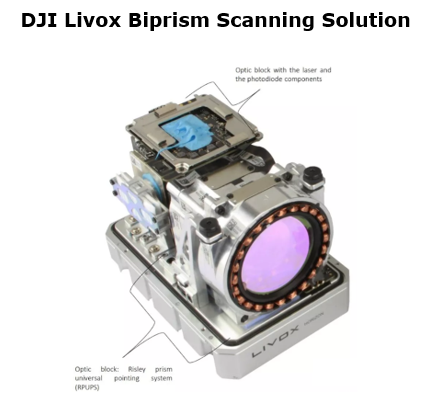
ARCFOX Alpha S Huawei HI is the first model equipped with Huawei’s three 96-channel LiDARs on the center and both sides of the front. Released in December 2020, the LiDAR has the maximum detection distance of 150m (@10% reflectivity), the field of view of 120°×25°, and the resolution of 0.25°×0.26°.
Combined with other sensors (6 radars, and 13 cameras and 12 ultrasonic radars), the LiDARs can achieve 360° coverage.
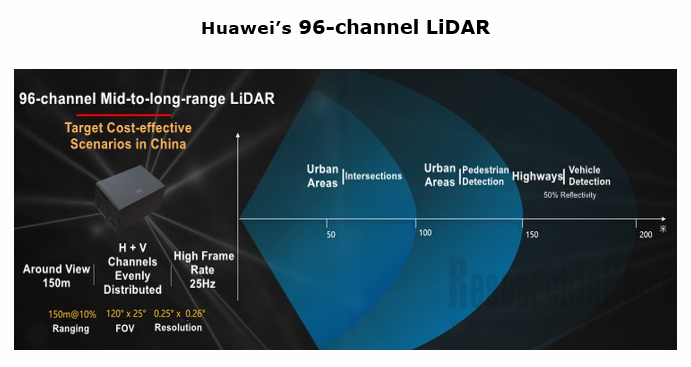
Huawei deploys long, medium and short-range LiDARs with a rotating mirror scanning architecture. Like Valeo Scala 1, Scala 2, the LiDARs comply with National Automotive Standards and are available on cars.
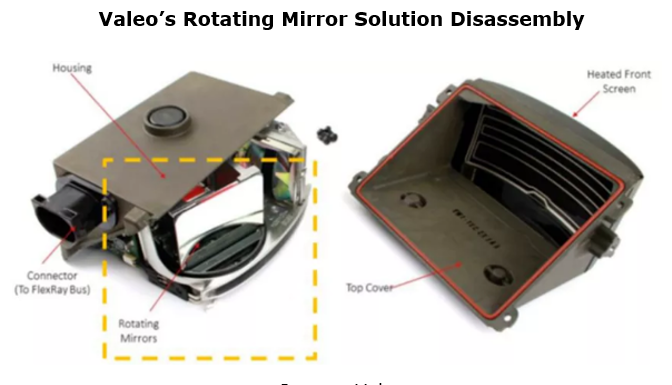
In addition to Huawei and Valeo, Innovusion and Luminar adopt similar technical solutions which however exploit two-axis rotating mirror scanning. They will soon conduct mass production for NIO ET7 and SAIC R ES33.
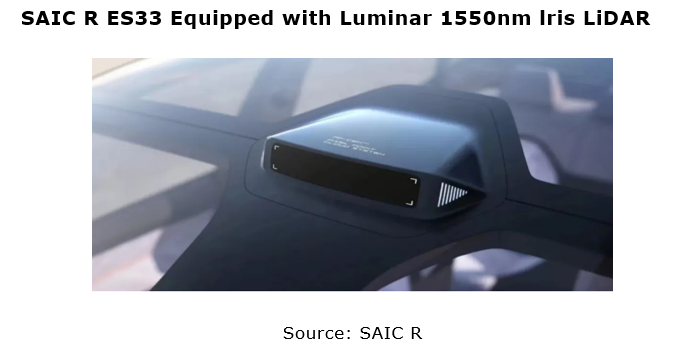
Luminar LiDAR features unique technical advantages: 1550nm wavelength (mainstream: 905nm) at the transmitting side, the low-cost InGaAs detector at the receiving side, self-made fourth-generation custom ASIC chips, and a 2D rotating mirror scanning method.
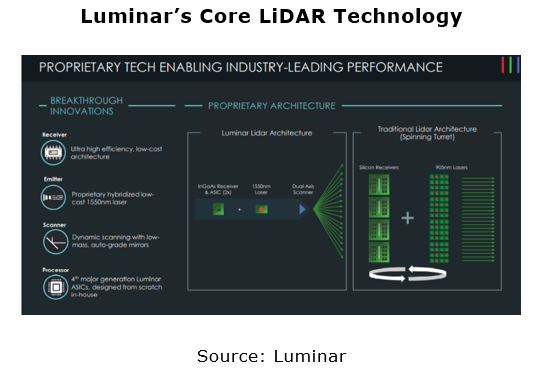
Luminar's Iris LiDAR based on this architecture has a detection distance of up to 250m (@5% reflectivity), and can detect dark objects on the road beyond 250m, with the resolution of up to 300PPD and the angular resolution of 120°×30°. At the same time, it has low costs. The price of IRIS for L2 advanced assisted driving is US$500; for L4/L5autonomous driving, it is less than US$1,000.
Innovusion and Luminar are alike in technology path. Both use 1550nm wavelength, fiber laser, and dual-axis rotating mirror scanning solution.
In January 2021, NIO ET7 was released, equipped with Innovusion's Falcon LiDAR. It will be mass-produced in 2022Q1.

In addition, RoboSense's MEMS LiDAR --- RS-LiDAR-M1 will soon be carried on Lucid Air. RoboSense released the RS-LiDAR-M1 SOP in January 2021, and will start mass production and delivery of the designated project in 2021Q2.
This product adopts RoboSense’s patented MEMS technology, with the farthest detection distance of 200m (150m@10%), the field of view of 120°×25°, and the resolution of 0.2°x0.2°.
In addition to RoboSense, players using MEMS technical solution include Innoviz, AEye, Pioneer, HESAI, Leishen Intelligent Systems, Zvision, etc. The third-generation product of Valeo’s is also based on MEMS technology.
Innoviz's InnovizOne will be installed on the new BMW iX in 2021; Valeo MEMS is expected to see mass production around 2022.
Main MEMS LiDAR Vendors and Their Typical Products
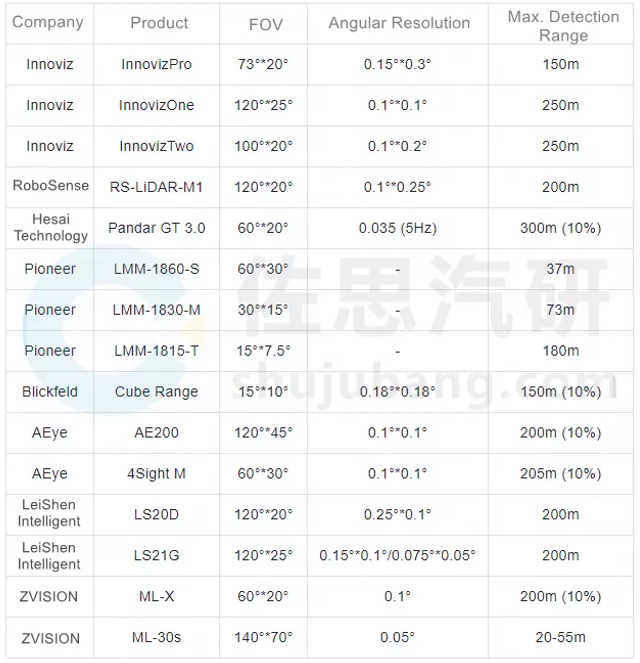
Source: ResearchInChina
China Automotive Ultrasonic Radar and OEM Parking Roadmap Research Report, 2022
In 2021, ultrasonic radar shipments hit 100 million units, and intelligent parking became a crucial engine.1. In 2025, China’s ultrasonic radar installations will exceed 140 million units.
According...
DENSO CASE (Connectivity, Automation, Sharing and Electrification) Layout Research Report, 2022
DENSO CASE Research: The semiconductor business will help it go "from Toyota to the world”
ResearchInChina has released DENSO CASE (Connectivity, Automation, Sharing and Electrification) Layout Resea...
China Roadside Edge Computing Industry Report, 2022
Roadside Edge Computing Research: how edge computing enables intelligent connected vehicles?
Policies and standards for roadside edge computing are implementing one after another, favoring the boom o...
Chinese ADAS and Autonomous Driving Tier 1 Suppliers Report, 2021-2022
Autonomous Driving Tier 1 Suppliers Research: the installation rate of L2 and above autonomous driving functions in passenger cars hit over 30% in 2022Q1.
In 2022Q1, the installation rate of L2 and a...
Global and China Electronic Rearview Mirror Industry Report, 2021-2022
Electronic rearview mirror research: the streaming rearview mirror installations soared by 73% in 2021.
This report combs through and summarizes the global and Chinese electronic rearview mirror mark...
Global and Chinese Automakers’ Modular Platforms and Technology Planning Research Report, 2022
Research on Automakers’ Platforms and Their Planning: the Strategic Layout Directions of 32 Automakers
At present, global automotive industry is in the midst of profound changes unseen in a century....
Automotive Intelligent Cockpit Platform Research Report, 2022
Research on Intelligent Cockpit Platforms: Intelligent cockpits rush into a new era of "cross-domain integration and layered software design"
Cockpit hardware platform field: Faster cross-domain inte...
Global and China Flying Car Industry Research Report, 2022
ResearchInChina has released “Global and China Flying Car Industry Research Report, 2022".
A flying car is a three-dimensional vehicle. Broadly speaking, it is a low-altitude intelligent autonomous t...
Global and China Passenger Car T-Box Market Report, 2022
Passenger car T-BOX research: T-Box OEM installation rate will reach 83.5% in China in 2025
ResearchInChina has published Global and China Passenger Car T-Box Market Report 2022 to summarize and ana...
Global and China Purpose Built Vehicle (PBV) and Robocar Report, 2022
PBV and Robocar research: new idea of building brick cars, a new car type for future mobility Building brick cars moves the cheese of traditional OEMs.
Purpose built vehicle (PBV) refers to special ...
China Automotive Voice Industry Report, 2021-2022
Automotive voice market: The boom of self-research by OEMs will promote reform in the supply mode
Before the advent of fully automated driving, the user focus on driving, and voice interaction is sti...
Global and China Automotive Emergency Call (eCall) System Market Report, 2022
Automotive eCall system: wait for the release of policies empowering intelligent connected vehicle safetyAt the Two Sessions held in March 2022, more than 10 deputies to the National People's Congress...
Global and China Leading Tier1 Suppliers’ Intelligent Cockpit Business Research Report, 2022 (II)
Tier1 Intelligent Cockpit Research: The mass production of innovative cockpits gathers pace, and penetration of new technologies is on a rapid riseGlobal OEMs and Tier 1 suppliers are racing for the i...
Global and China Leading Tier1 Suppliers’ Intelligent Cockpit Business Research Report, 2022 (I)
Tier1 Intelligent Cockpit Research: The mass production of innovative cockpits gathers pace, and penetration of new technologies is on a rapid riseGlobal OEMs and Tier 1 suppliers are racing for the i...
China Commercial Vehicle Intelligent Cockpit Industry Report 2021
Research on Intelligent Cockpits of Commercial Vehicles: Heading for Large Screens, Voice Interaction, Entertainment and Life
Following AD/ADAS functions, the intelligent configuration of the cockpit...
Automotive Ultra Wide Band (UWB) Industry Report, 2022
UWB got initially utilized in the military field, and began to be commercially applied after the release of criteria for UWB commercialization in 2002. In 2019, Car Connectivity Consortium (CCC) liste...
China Automotive Distribution and Aftermarket Industry Report, 2022-2027
Since the introduction of 4S store model into China at the end of 20th century, China's authorized dealer system has gradually developed from a single-store-based mode to a group-based mode, and from ...
Global and China Skateboard Chassis Industry Report, 2021-2022
Research into skateboard chassis: where to sell, how to sell and to whom it is sold
Rivian, a new carmaker based on skateboard chassis, is quite popular in the market and becomes the focus of the aut...